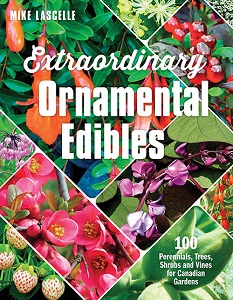 Phormium ‘Rosie Chameleon’ – A hard to find cultivar with rose-pink strap-like leaves with bronze-green edging that literally glow in the sun – it has a slightly arching habit. Hardiness can be a problem so mulch with coarse bark nuggets and temporarily cover with conifer boughs or insulation cloth (N-Sulate) during freezing temperatures. Grows 3-4′ high by 3′ wide. Hardy to zone 7-8.
Phormium ‘Rosie Chameleon’ – A hard to find cultivar with rose-pink strap-like leaves with bronze-green edging that literally glow in the sun – it has a slightly arching habit. Hardiness can be a problem so mulch with coarse bark nuggets and temporarily cover with conifer boughs or insulation cloth (N-Sulate) during freezing temperatures. Grows 3-4′ high by 3′ wide. Hardy to zone 7-8.
 Phormium tenax ‘Yellow Wave’ – This RHS Award of Garden Merit winner features broad sword-like foliage of mid green, heavily streaked in bright yellow and cream. Phormiums are clumping evergreen perennials that prefer part to full sun (they are not shade plants) with good soil drainage. Drought tolerant once established. Grows 3-4′ high by 4′ wide. Zone 7-8.
Phormium tenax ‘Yellow Wave’ – This RHS Award of Garden Merit winner features broad sword-like foliage of mid green, heavily streaked in bright yellow and cream. Phormiums are clumping evergreen perennials that prefer part to full sun (they are not shade plants) with good soil drainage. Drought tolerant once established. Grows 3-4′ high by 4′ wide. Zone 7-8.
 Phormium tenax ‘Sundowner’ – Probably one of the most beautiful of the New Zealand Flax with upright bronze-green strap-like foliage with translucent reddish-pink margins (and the occasional inset strip) that light right up in the rays of a sunset or sunrise. Given their architectural appeal they also make attractive container specimens. Grows 3-5′ high and wide. AGM. Zone 7-8.
Phormium tenax ‘Sundowner’ – Probably one of the most beautiful of the New Zealand Flax with upright bronze-green strap-like foliage with translucent reddish-pink margins (and the occasional inset strip) that light right up in the rays of a sunset or sunrise. Given their architectural appeal they also make attractive container specimens. Grows 3-5′ high and wide. AGM. Zone 7-8.
 Phormium cookianum ‘Platt’s Black’ – One of the darkest Phormiums available with deep purplish-black to dark bronze foliage of arching strap-like leaves. The Maoris of New Zealand used Phormium for it fibers making rope, fish nets, baskets, mats and even clothing out of it. Contrast ‘Platt’s Black’ with gold foliage such as Sedum ‘Angelina’. Grows 3′ high by 3-4′ wide. Zone 7-8.
Phormium cookianum ‘Platt’s Black’ – One of the darkest Phormiums available with deep purplish-black to dark bronze foliage of arching strap-like leaves. The Maoris of New Zealand used Phormium for it fibers making rope, fish nets, baskets, mats and even clothing out of it. Contrast ‘Platt’s Black’ with gold foliage such as Sedum ‘Angelina’. Grows 3′ high by 3-4′ wide. Zone 7-8.
 Phormium cookianum ‘Flamingo’ – An aptly named cultivar of New Zealand Flax with bronze-green leaves irregularly variegated with reddish-pink and cream. Phormium blends in well with ornamental grasses, Crocosmia and some of the taller stonecrops such as ‘Matrona’ and ‘Autumn Joy’ – making for a striking late summer display. Grows 2-3′ high and wide. Hardy to zone 7-8.
Phormium cookianum ‘Flamingo’ – An aptly named cultivar of New Zealand Flax with bronze-green leaves irregularly variegated with reddish-pink and cream. Phormium blends in well with ornamental grasses, Crocosmia and some of the taller stonecrops such as ‘Matrona’ and ‘Autumn Joy’ – making for a striking late summer display. Grows 2-3′ high and wide. Hardy to zone 7-8.
















































